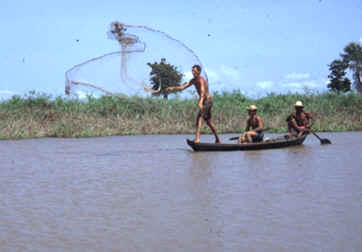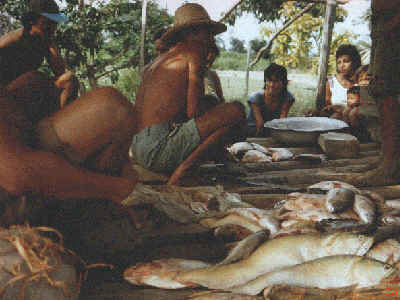Fishing
Fish have always been an abundant source of protein in the Amazon. There are over 1000 species of fish in the basin. The selling of salted fish has always been an integral part of floodplain livelihoods (see Veríssimo for example 1973 for an account of fishing in Amazonia at the beginning of the twentieth century). Mostly, it was the larger scaled fish (e.g. Pirarucu and tambaqui) that were salted and sold to traders or to bosses in town. The surge in the demand for various species of fish indigenous to the Amazon basin came from urban centres within Amazonia from the 1950s, and from an international market (Goulding 1983: 192, Furtado 1990). Historically fishing has used diverse technologies and is organised in different ways depending on the season.
 This picture shows a man having just thrown a hand cast net. This method was introduced into Brazil by the colonial Portuguese.It is round and leaded weights around the perimeter. It lands flat on top of the water. As it falls it is drawn in, thereby trapping the fish. As you can imagine it requires great skill to do properly - an much strength since it is thrown many times in succession. It is particularly effective at chasing fish along a river bank or migrating shoals.
This picture shows a man having just thrown a hand cast net. This method was introduced into Brazil by the colonial Portuguese.It is round and leaded weights around the perimeter. It lands flat on top of the water. As it falls it is drawn in, thereby trapping the fish. As you can imagine it requires great skill to do properly - an much strength since it is thrown many times in succession. It is particularly effective at chasing fish along a river bank or migrating shoals.
There are basically two types of commercial fishing in Amazonia. The first is professional, itinerant, urban-based, large scale and the second artisanal and small-scale [1]. The former are relatively new to fishing and are taking advantage in the changes in technology in the last forty years (e.g. diesel boats, ice-storage, mono-filament nets). They are highly predatory and can carry many scores of tonnes of fish and ice The latter are the floodplain inhabitants who are now exploiting one more opportunity. They do so by upgrading their fishing methods from the cast net to the gill net and using diesel engines to power boats, with a carrying capacity of between half a tonne to ten tonnes (though most are around four, see McGrath et al 1993). In many cases, the people who were cultivators of jute until the mid 1980s were the same who were involved in commercial fishing at the beginning of the 1990s. [2]
The decline of jute as a primary remunerator for riverine populations has not brought an end to patron-client relations. Instead, the new fish exporting factories, frigoríficos, have resumed where the old patrons, often the same people again, left off. This new patron-clientilism comes in the form of advancing credit to buy equipment and offering free ice. It is however not as generalised as before, since the bosses do not provide basic goods such as food or other household items.
 Second Picture: When fish are caught they are either put on ice in storage containers, or they are salted. The traditional form has been to salt fish immediately and either to sell it on or to keep it for household consumption at a later date. Like net mending it is an emminently social occasion with lots of people gathering around and talking.
Second Picture: When fish are caught they are either put on ice in storage containers, or they are salted. The traditional form has been to salt fish immediately and either to sell it on or to keep it for household consumption at a later date. Like net mending it is an emminently social occasion with lots of people gathering around and talking.
A whole catalogue of technological improvements for fishing have been introduced after the second world war and they are in now daily use widely. These changes have meant a huge increase in the amount of Amazonian fish being caught, sold and exported in the twentieth century (see Furtado 1984: 19, and Bartheim 1994: 496 for some figures). Inevitably, this has lead to a stress on local fisheries (the most productive) and a series of conflicts.
These conflicts are basically about ownership of and access to lake fisheries between professional, itinerant fishing boat owners and local residents. Representatives of local residential communities say outsiders invade, invadir, what they regard in their proximity as their `own' (cf. McGrath et al 1993 for an analysis of this situation). The response to these invasions has been to block off access to outsiders. This has led floodplain dwellers to claim control of lake fisheries and the development of communal management plans in the form of lake reserves. Closing the lakes to outsiders though has led to the escalation of the conflict throughout the Amazon. In this regard, McGrath et al (1993) argue there are two future paths that the floodplain economy and society of the Lower Amazon could take. The first is the way of sustainable development of the area's resources. This would be based on the strengthening of communal ties and the diverse use of the resources on the floodplain. The second is the way of the destruction of local communities and their replacement by large scale cattle farms and fishing interests. This would ultimately lead to the over-exploitation of the fisheries and an unsustainable and reductionist use of resources. 
The third picture is of men loading ice onto a boat. Geleiras are ice storage boats, used for keeping fish. The black birds are vultures (urubus) who wait for scraps of fish to be thrown. They are very effective street cleaners.
Historically, the floodplain has supported a concentrated and relatively large population (given its much greater population density compared to the terra firme), who have practised a diverse range of activities in harmony with changes in the rise and fall of the river. This diversity of economic possibilities has served them well. It has allowed them to take advantage of new remunerative possibilities and maintain its use of a livelihood base to provide daily foods such as fish, game, manioc flour, fruits and vegetables. For McGrath et al and a number of others the floodplain is now facing a crisis. If the fisheries are being severely depleted, then not only are people loosing a fund of cash and a crucial part of the eco-system but a vital source of nourishment. And without this baseline as a constant, it is difficult to imagine life on the floodplain as being possible.
There are clearly no easy solutions to these problems.
Footnotes
[1]A third category somewhat peripheral to my concerns is the urban fishermen. These people are based on towns, often are recent rural migrants, and fish in canoes in proximity to urban areas. Due to its scale consumption is for household use or is distributed along kinship networks.
[2]The working teams on these boats are usually made up of kinspeople. For example, it is common for a father to employ his sons and nephews on his boat. The normal procedure is for the owner to pay his fishermen for the fish they catch by the kilo, taking a 50% cut for himself as owner.


 This picture shows a man having just thrown a hand cast net. This method was introduced into Brazil by the colonial Portuguese.It is round and leaded weights around the perimeter. It lands flat on top of the water. As it falls it is drawn in, thereby trapping the fish. As you can imagine it requires great skill to do properly - an much strength since it is thrown many times in succession. It is particularly effective at chasing fish along a river bank or migrating shoals.
This picture shows a man having just thrown a hand cast net. This method was introduced into Brazil by the colonial Portuguese.It is round and leaded weights around the perimeter. It lands flat on top of the water. As it falls it is drawn in, thereby trapping the fish. As you can imagine it requires great skill to do properly - an much strength since it is thrown many times in succession. It is particularly effective at chasing fish along a river bank or migrating shoals.  Second Picture: When fish are caught they are either put on ice in storage containers, or they are salted. The traditional form has been to salt fish immediately and either to sell it on or to keep it for household consumption at a later date. Like net mending it is an emminently social occasion with lots of people gathering around and talking.
Second Picture: When fish are caught they are either put on ice in storage containers, or they are salted. The traditional form has been to salt fish immediately and either to sell it on or to keep it for household consumption at a later date. Like net mending it is an emminently social occasion with lots of people gathering around and talking. 